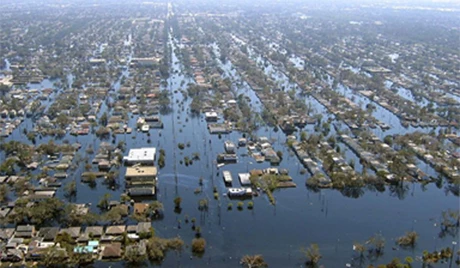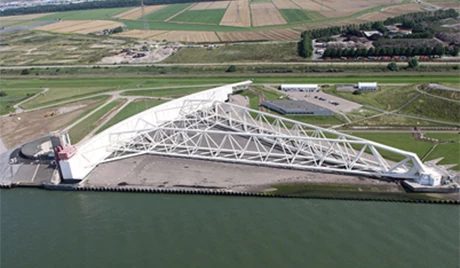The flooding of New Orleans, caused by Hurricane Katrina in 2005, illustrates the vulnerability of cities that are highly dependent on coastal defenses. Photo: NOAA [http://commons.wikimedia.org/wiki/File:Katrina-new-orleans-flooding3-2005.jpg]
Increasing flood risks create a major political and institutional challenge for the world’s coastal cities, as ambitious and proactive action at the local level over the next decades will be needed to avoid large-scale flood disasters. However, the implementation of flood risk management policies meets many obstacles.
In a recent study written with colleagues Colin Green, Robert Nicholls and Jan Corfee-Morlot as part of an OECD project on urban vulnerability, we estimate how flood risks could change in the future in 136 coastal cities, in response to increasing population and wealth, local environmental change, and climate change. We find that because current flood defenses and urbanization patterns have been designed for past environmental conditions, even a moderate change in sea level is sufficient to make them inadequate, thus magnifying flood losses to catastrophic levels. If no action is taken to reduce flood vulnerability, most coastal cities would become inhospitable and dangerous places to live, with annual losses in excess of US$1 trillion dollars.
What can be done?
Our analysis suggests that upgrading defenses could mitigate these losses and the impacts of rising sea levels. However, these upgrades need to include a package of risk management policies. First, coastal defenses should make use of the protection the environment can offer for free: Marshes, seagrass beds, coastal and kelp forests, and coral reefs provide natural buffers that absorb the energy from waves and storms, making it easier and cheaper to protect urban development. In addition artificial constructions are also required to provide full protection. We are not only talking about dykes: a city surrounded by dykes will need pumping systems to drain rainfall water, and a harbor will need moving barriers to let ships in and out of the port.
With climate change and subsidence, more and more cities will need to invest in expensive coastal protection, such as the Maeslantkering, a storm surge barrier near Rotterdam in the Netherlands. Photo: Joop van Houdt/Rijkswaterstaat. [http://commons.wikimedia.org/wiki/File:Maeslantkering_northern_half_3.jpg]
Furthermore, decision makers need to account for local subsidence (the fact that the ground is sinking relative to sea level), which amplifies the effect of global sea level rise on local water levels. Subsidence is accelerated by human activities, like water and oil extraction. To minimize local sea level rise and therefore flood risks, it is critical for many cities such as Guangzhou, Bangkok or Kolkata to reduce their water and oil extraction, again at a significant cost.
Overall, cities need a full protection system, not just a few dykes. Around $2 billion in investment plus a few percent of this sum in annual maintenance is a ballpark estimate of how much each city will need. In an environment of scarce resources for local authorities, especially in poor countries, mobilizing such resources will be a real political and institutional challenge.
Beyond flood defenses
Coastal protection infrastructure will need to be complemented with smart land-use planning: cities can keep their flood risk manageable only by preventing new urban development in locations that are too risky or too costly to protect. Here, developing countries have a real window of opportunity. Because urbanization is still ongoing and as infrastructure is being built now, developing countries can still implement smart urban policies to drive new urbanization toward safer places. If they do so, they can prevent the development of the most vulnerable – and costliest to protect – areas, and become less exposed to flood risks.
However, most developing countries will face an uphill battle when trying to manage urbanization toward safe places: weak institutions, lack of solid land tenure, lack of enforcement of building norms, and extension of informal settlements are strong obstacles.
Preparation is key
Importantly, everybody needs to be aware that flood defenses can always fail. The more population and assets depend on them, the bigger a disaster can be. It means that in parallel with improving coastal protections, local authorities need to plan for the worst: they need to install early warning systems – to make sure the population is informed when a storm is approaching; they need to prepare for large-scale evacuation – especially to make sure the poorest can leave the most dangerous areas; they need contingency plans to manage crisis and emergency services; and they need to support recovery and reconstruction – through social protection schemes, well-regulated insurance systems, and post-disaster support.
The real challenge here is that an increase in risk cannot be directly observed. What we see is the disaster, and by that time it is too late as the risk has already materialized. For these cities, the one-trillion dollar question is to know whether they will be able to take the appropriate measures before a disaster occurs. But decision-makers will face deep political economy obstacles when they try to invest billions of scarce US dollars in protection investments that will deliver benefits over many decades, and in the form of avoided losses that nobody can see.
From urban planning to institution development and large-infrastructure financing, these questions are of prime interest for the World Bank Group, which can play a major role in supporting cities in their risk management. The upcoming World Development Report 2014 – "Risk and Opportunity: Managing risk for development" – will help by providing an in-depth discussion of the obstacles to and opportunities for better risk management, with practical policy recommendations for suitable institutional settings for improving risk management.




Join the Conversation